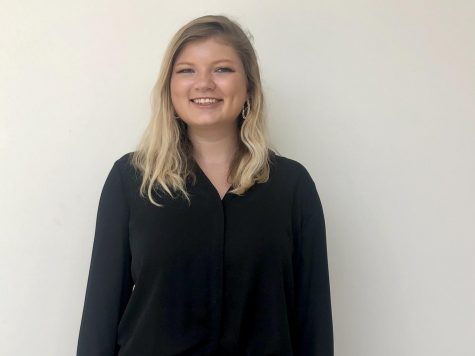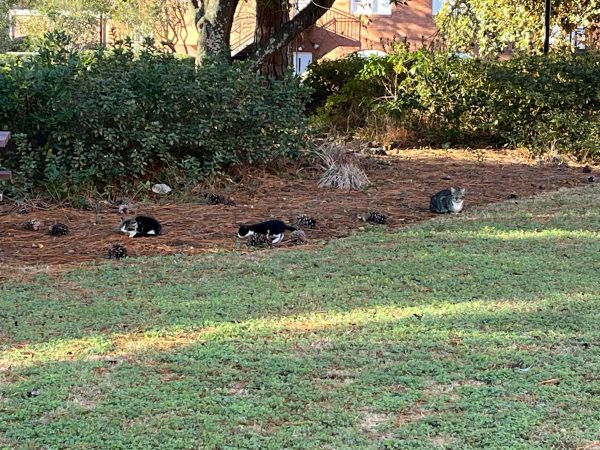The Roots of Southern: Georgia Teachers College in the 1950’s
January 17, 2019
Georgia Southern University was much different back in the late 1950s. When the college first opened, it was known by a different name: Georgia Teachers College. The campus was not much bigger than sweetheart circle; the class size was in the hundreds; freshmen students were known as ‘rats’; the only sports the college had was baseball and basketball; students would hitchhike into town; women had curfews. Life was very different.
I spoke to five Georgia Southern alumni who graduated in late ‘50s to find out what life at the college was like back then.

Photos from Reflector yearbooks
Helen Jackie Yates hasn’t missed a Georgia Southern home basketball game since 1986. She is a proud alumni, and she graduated in 1957 with a major in physical education. Yates serves as the secretary for the Men’s Basketball Roundball Club (ERBAA). When she attended Georgia Teachers College, she went by Jacquelyn Mikell
“I’m not sorry I didn’t go to the University of Georgia…I think my school can hold its own,” Yates said.

Photo from Reflector yearbooks
Dave Esmonde, nicknamed “Yank” by his team, was a dedicated baseball player. He was on the team all four years during his time at the college and was a part of the first baseball team at Georgia Teachers College that played in the National Collegiate Athletic Association (NCAA) men’s baseball tournament. He majored in math and graduated in 1958.
“The humor and the imagination that the people had at Georgia Teachers College at that time was unbelievable … We could entertain each other … I think we just had a lot of good, wholesome fun,” Esmonde said.

Photo from Reflector yearbooks
Larry Hyde wrote for The George-Anne “almost from the day [he] was on campus.” He wrote a column called “Hyde and Seek” and held positions as a news editor and sports editor for The George-Anne. He was also the editor for The Reflector, a yearbook at the time, in ‘58. He is a navy veteran and was stationed at Pearl Harbor two years before coming to Georgia Teachers College. He graduated in 1958 with a major in health and physical education.
The people Hyde met changed his life. He treasures the friendships he made and still has some today.

Photo from Reflector yearbooks
Jane Jackson Highsmith was a part of the last class to graduate from Georgia Teachers College. She majored in elementary education and graduated in 1959. Jackson Highsmith was The George-Anne’s features editor for four years, and she was secretary of the student council.
Jane Jackson Highsmith was a part of the last class to graduate from Georgia Teachers College. She majored in elementary education and graduated in 1959. Jackson Highsmith was The George-Anne’s features editor for four years, and she was secretary of the student council.
Jackson Highsmith was very homesick when she first got to Georgia Teachers College. “It taught me to endure the tough times and then I figured out kind of who I was during that time. I met my husband down there. I made the best friends I’ve ever had,” Jackson Highsmith said.

Photo from Reflector yearbooks
Aubrey Highsmith said he always had a saw and hammer in his hand ever since he was big enough to hold one, which is how he knew Georgia Teachers College’s industrial arts degree was for him. He was vice president of the student council and graduated in 1958.
“A large number have always appreciated the school…I think in our friendship circle, everybody had a great appreciation for the education we got there during that time,” Highsmith said.
Jane Jackson Highsmith and Aubrey Highsmith met at Georgia Teachers College and have been married for 59 years. They both serve on the Jackie & Averitt graduate school foundation board.

Photo by Noelle Walker
Traditions:
The Lantern Walk:
This tradition has lasted until this day. The lantern walk is where soon-to-be graduates walk around campus and say their goodbyes.
Yates recalled that everyone would wear their caps and gowns. They also had designated speakers, and they would say a farewell speech to buildings. Business major business buildings
Rat Day:
Rat Day was something all freshmen had to participate in,unless they were a military veteran. Each freshman was given a rat hat they had to wear everywhere.
“You wore your cap to signify that you were a lowly freshman,” Yates said.
This lasted for a few weeks, but the freshmen were not at the mercy of the sophomores until Rat Day. Rat Day was unannounced, and the upperclassmen could make them carry their books, get their meals or even do something silly like act like an airplane.
“If they screamed ‘air raid, air raid,’ you had to stand on one foot, lean forward, and say a poem … I said it so much I’ll never forget it,” Jackson Highsmith said:
I am a lowly freshman
I have no poise nor grace
I must respect the sophomores
To show I know my place
My place is very low indeed
I am a humble soul
I crawl around like a centipede
When I should crawl in a hole
I am a lowly freshman. I have no sense of knowledge
To learn respect and discipline
Is why I came to college!
Jackson Highsmith also recalls some other things the sophomores made the freshmen do. She had to tell Jack N. Averitt, Ph.D, the head of the social studies department and a professor in a “no-nonsense class,” “You tell ‘em cabbage, you got the head” every ten minutes. “It’s so silly, but it’s just a thing of horror,” Jackson Highsmith said. Another boy had to say “You tell ‘em cigar, your butt’s been chewed.”
Yates had a friend who had to stand up on a table in the dining hall and sing “Mary Had a Little Lamb.”
There was one night known as “The Running of the Rats.” It would take place in the fall, on a cool, rainy night. The boys would be woken up and taken out of their beds in the middle of the night. Esmonde said that you would have “nothing on but your shoes, your rat hat and your scivvies.”
“The [upperclassmen] had a big mud puddle, and you had to go jump in that mud puddle and slide like you were a baseball player … then you had to run over to the woman’s dorms and sing songs to them over there,” Esmonde said.
There was even a parade downtown. The band would play as the ‘rats’ marched. Sophomores would make them do crazy things during the parade.
“Rat Court” would occur on the night of Rat Day. Sophomores would be the jury and dish out punishments to those who didn’t behave properly as rats. Sophomores were dressed in black, and they were somber and scary looking, Jackson Highsmith recalled. One punishment involved ice blocks that students had to sit on.
“After Rat Court, you could officially be a student,” Jackson Highsmith said.
The juniors and seniors were merely spectators. “We had risen above all that foolishness,” Highsmith said.
Yates said it was all in good fun.
Watermelon Cutting:
The annual watermelon cutting still goes on today. The president cuts watermelon every summer. “The tradition began in 1948 when late President Zach Henderson wanted to provide a cool treat to the students, faculty and staff who were still on campus during the hot summer months,” according to the Georgia Southern University’s traditions page.
Friday Night Movies & Saturday Night Dances:
They would show movies every Friday and hold dances every Saturday. It was a great chance to socialize since the women were only allowed to go out a certain amount of nights per week and these would not count as one of their nights.
There were three major dances a year: The Starlight Ball, Christmas Ball and Faculty Ball.
The Panty Raid:
This only lasted a couple of years. Boys who lived in the dorm would stand in front of girl’s dorm and yell “panty raid” repeatedly, and the women would throw out a pair of panties.
“That was about the wildest thing we did,” Yates said.
Sadie Hawkins Day:
This was the one time girls officially were able to invite the guys. It was held outside on the tennis courts, and it was the only time is was acceptable to dress casually. If a girl had a date, she would call for him from her dorm. It was the reversal of what the boys did.
May Day:
There was a May Queen and a May Court. Elementary through twelfth graders came out and did a performance, and the children danced around the maypoles. Everyone in town came.
“At that time, Georgia Southern and Statesboro were very integrated,” Yates said.
Beauty Pageant:
The different clubs would nominate a girl to be in the beauty pageant. The pictures of each candidate would be sent to a judge.
Sunday Morning Church Bus:
The Baptist Church had a bus that was called Gabriel. Yates recalls that the church bus was known as Gabriel blowing the horn every Sunday morning.

Fashion:
Esmonde describes a lot of the fashion trends with the guys: jeans, t-shirts and v-neck sweaters were popular in fall and winter. White saddles and penny loafers were also very popular, and almost everyone had a pair of white bucks. There was no sloppiness, and almost everyone was cleanly shaven and had a crew cut.
“If you were going out … it was a v-neck sweater,” Esmonde said.
No one wore shorts; the guys wore jeans or khakis, Yates said.
Eventually, Bermuda shorts with socks up to the knees became popular as well.
Hyde recalls a story of when Bermuda shorts hit campus. Unfortunately, everyone was not a fan. ”There was an elderly lady in the dining hall that did not think the dining hall was a place for Bermuda shorts, and she opposed any[one] wearing them to dine,” Hyde said.
Hyde and a friend, Louis “Doc” Green, decided to go before the student council. Green dressed in a pair of Bermuda shorts and stood on a chair while Hyde asked, “What is indecent about the way this student is dressed to attend classes and all activities at Georgia Teachers College?” Dress regulations were changed the next quarter.
Women wore long skirts and dresses. They could wear jeans on the weekend, but they would have to put a raincoat on if they left the dorm while on campus. Velvet capris pants were also popular with the women, even though they were not allowed to wear them on campus because of their dress code (see rules).
“Most of the boys smoked and they would roll the cigarette up in the sleeve of their t-shirt. That’s what we called ‘cool’ back then,” Jackson Highsmith said.
Sports:
The school only had basketball and baseball. They were known as the Professors, and the games were very popular. The baseball team played on the same field we do now.
“Sports were the big thing on campus,” Yates said.
During Esmonde’s junior year, after the baseball season ended, the team took a bus and went into South Carolina. They went across a wooden bridge with a little stream under it and played volleyball on the beach all day. They maybe passed two cars on the road. Esmonde said there was nothing there except one gas station. That beach is now known as Hilton Head.
“Little did I know at that time that that place would become an absolute haven like it is today,” Esmonde said.
Rules:
Compared to women, men had hardly any rules. They did not have a curfew, a limited number of nights out or a dress code. They could do whatever they wanted.
“Of course, there’s not much you can do if you don’t have girls,” Yates said.
Discipline was handed out by house council. If you violated the rules of the dorm, you were called down to house counsel to defend yourself. You could be “campused” which meant you could only stay on campus. However, if you were restricted, you could only go to class and to the dining hall.
Guys were allowed to come into the girl’s parlor after dinner until seven o’clock. At seven, the house mother would blow a whistle, and the guys would have to go unless they had a date. After this, the women were in study hall until 10.
Freshmen women were only allowed one night out a week; sophomores two nights; juniors had three; seniors were unlimited. Freshmen had to double date, and each person had to sign a date slip before leaving.
“If you left, you had to sign out. If you went out off the campus you had to pull out a date slip. You had to tell with whom you were leaving and where you were going,” Jackson Highsmith said. If your parents called, the people in the dorm knew where you were going.
They had mandatory chapel twice a week. Yates said you could cut class, but not chapel. She also said that if you skipped, Zach S. Henderson, Ph.D, would hunt you down.
“The only time we could wear anything other than a dress was after 9 o’clock at night if we wanted to go to The Blue Tideーthe little store where you could get only Coca-Colas and crackers and candy bars,” Jackson Highsmith recalls.
“I think some things are too restricted…the bigger we get, the more rules,” Yates said.
Mose Bass:
Mose Bass was an African American janitor at Cone Hall, which was the junior and senior boys dormitory at the time. He was a legend and an icon, and he even had a yearbook dedicated to him one year.
Mose did everything for the guys; he’d wake them up in time for class and make sure they studied, Yates said, “They had a house mother, but Mose took care of the boys,” Yates said.
If sign for a party or something was posted around campus, someone would come by and write “Approved by Mose Bass.” It was an unofficial slogan.
Esmonde said that his roommate, Vaughn Haul, and Mose were friends. Haul would go hunt in the country, Mose would cook up his game, and they would eat together.
“He was a good friend to all the boys on campus,” Esmonde said.
Cost:
“My dad gave me two 100 dollar bills … they gave me two dollars change … Tuition was about 200 dollars a quarter. There might’ve been some other fees attached, I don’t remember, but it was around that figure,” Highsmith said.
Jackson Highsmith said she could go for $1,000 a year for everything: tuition, books, spending money.
“Most of the people that we know that went here have really become successful because they had to work hard. They grew up working hard, they knew that this was a gift that everybody couldn’t get an education that to be here was a gift so they didn’t squander it,” Jackson Highsmith said.
The Town and Campus Life:

Yates explained that they had the College Grill, Dixie Pig (drive-in), Knick Knack Grill, Franklin’s and Dairy Queen. There wasn’t a McDonald’s, Wendy’s or Arby’s. Gnats and Dingus Magees didn’t exist.
“College Grill” was where Gnats Landing is now. It was so close to campus that anyone could walk there, and, considering most students didn’t have cars, that’s what they did. Statesboro was much safer back then; everyone was familiar with each other. Because of this, people could easily hitchhike to their destination.
Esmonde recalls that he could get a chili dog plate from College Grill for 42 cents. “If you had five bucks in your pocket, you were ahead of the game,” Esmonde said.
The Skater Bowl, similar to the Clubhouse, was a skating rink, bowling alley and dance floor with a jukebox.
Jackson Highsmith said professors were very personal: “They always knew us and that had a lot of meaning, the personal interest the professors took in you, Jackson Highsmith said. You would be invited into their homes, and they knew who you were.
Hardly any students had cars. Highsmith recalls that the college didn’t have as many activities or resources as the school does now. “It was probably suitable for our time and our location in the state,” Highsmith said.
Sweetheart Circle has kept its name for decades. Yates recalled that there used to be a lot benches in sweetheart, and, after a meal in the dining hall, people would go and sit under the trees.
“I hope they keep the integrity of the original campus. It has so many memories and happy times,” Yates said.
“I can’t tell you how proud I am of Georgia Southern University. Living so far away, I don’t get to visit the campus. My last visit was for the 50 Year Celebration of the Class of 1958. When you stop and think, in Winter Quarter of 1955, there were around 7500 students at GTC. Now it is over 20,000. Look at all the opportunities people have to get an education in so many fields,” Hyde said.
“I loved Georgia Southern. I loved campus. I loved living here. And I still do. I like all the changes. A lot of people in town say that Statesboro has changed. You know, the traffic is horrible…it’s crowded. But how boring it would be without the students. They bring life into the church. They bring life into the community,” Yates said.
















